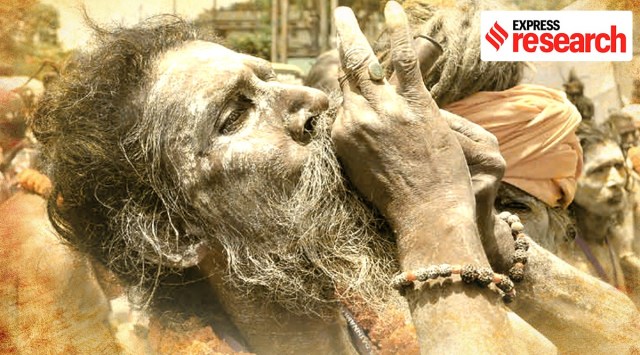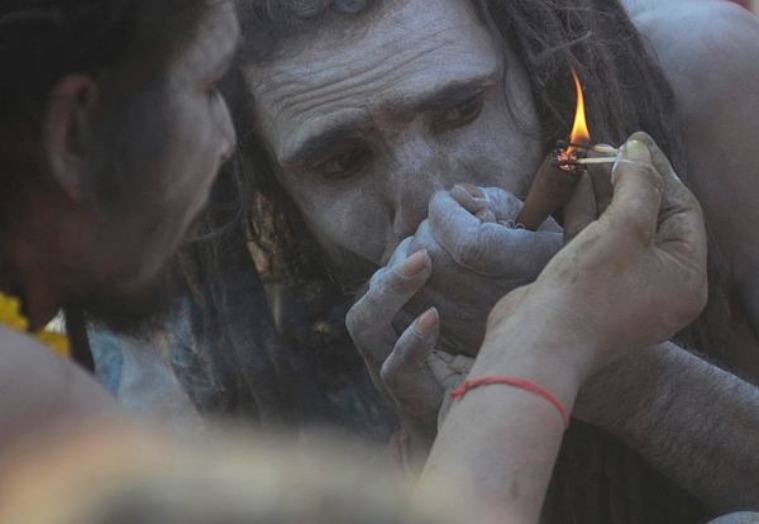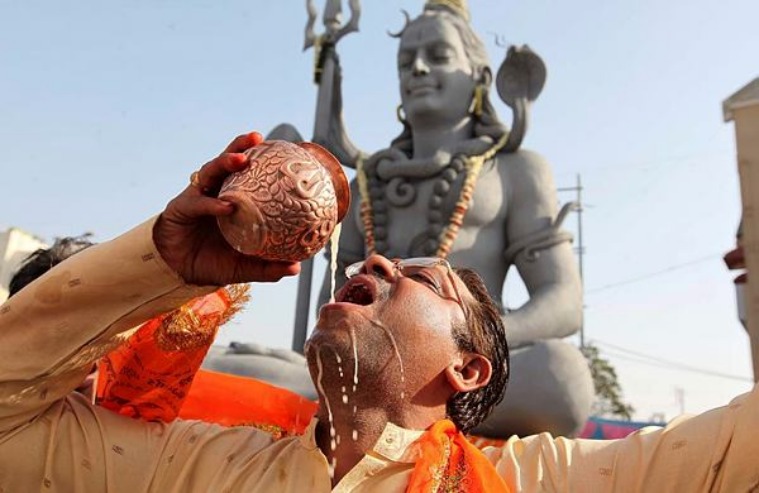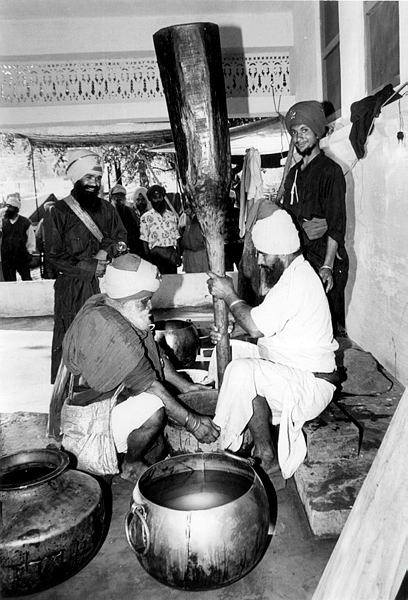- India
- International
Cannabis in India: A rather long story, with its highs and lows
So deeply intertwined is cannabis with religion in India, that one of the principal deities of Hinduism, Shiva, is given the sobriquet: ‘Lord of Bhang’.
 A Naga sadhu takes a puff at Ambubachi mela. (Express Photo by: Dasarath Deka)
A Naga sadhu takes a puff at Ambubachi mela. (Express Photo by: Dasarath Deka)Cannabis is illegal in India. But still its prevalence is remarkable across the social and spiritual landscape of India. It is in fact particularly popular among ascetics and mendicants, and a variant called ‘bhang’ is frequently consumed and offered as part of festivities. So deeply intertwined is cannabis with religion in India, that one of the principal deities of Hinduism, Shiva, is given the sobriquet: ‘Lord of Bhang’. And this stems from the rather long history of the plant in the subcontinent.
Social and spiritual acceptance of cannabis in India through the ages
A sun-loving plant, cannabis is known to have originated in the steppes of Central Asia, from where it was brought to India through human migration between 2000 and 1000 BCE. Geographer Barney Warf, in his research paper ‘High Points: An Historical Geography of Cannabis’, maintained that the plant was most likely introduced to India through the series of Aryan invasions.
However, unlike many other countries to which it was transported, “India developed a continuing tradition of psychoactive cannabis cultivation, often with medicinal and religious overtones”. Marijuana growing and consumption is known to have reached its “greatest efflorescence” in India… “local farmers often consulted with specialist poddar or parakdar, known as ‘ganja doctors’,” wrote Warf.
 Given its religious significance, weed is also ritually consumed by ascetics or sadhus. (Express Photo by Ritesh Shukla)
Given its religious significance, weed is also ritually consumed by ascetics or sadhus. (Express Photo by Ritesh Shukla)
Reference to cannabis along with its medicinal and spiritual properties is made extensively in Vedic literature. In the Atharva Veda, for instance, cannabis is lauded for being a cure to illnesses, and also for fighting away demons. One section of a hymn in the scripture, as translated by professor Mark S. Ferrara in his book ‘Sacred bliss: A spiritual history of cannabis’, read:
“May cannabis and Jangida (herbs) preserve me from Vishkandha (illness),- that brought to us from the forest, this sprung from the saps of husbandry.”
Ferrara noted that “practitioners of this ancient religious tradition utilised cannabis as a medicinal herb, and because of its centrality to charms and spells, cannabis was regarded a ‘sacred grass’ for its power to vanquish sickness, despair, and calamity”.

One of the most important treatises on medicine from the ancient Indian world, ‘Sushruta Samhita’ written between the third and eighth centuries BCE, recommended cannabis for phlegm, catarrh and diarrhoea.
At the same time, the Vedas also narrate a strong association between the deity Shiva and cannabis. Sociologist Theodore M. Godlaski, in his article, ‘Shiva, Lord of Bhang’, published in 2012, recounted a popular myth around the deity’s fascination with cannabis. “When the Gods stirred the heavenly ocean with the peak of mount Mandara, a drop of amrita (sacred nectar) fell from the sky. Where it landed, the first cannabis plant sprouted. Lord Shiva brought the plant down from Mount Mandara for the benefit of mankind,” noted Godlaski.
Given its religious significance, weed is also ritually consumed by ascetics or sadhus. More often they smoke the highly resinous buds of the female plant or the resin itself (hashish) in small clay pipes, which are locally referred to as chillum. Godlaski described in great detail the ritual of chillum smoking: “Chillum smoking is not done alone but in a smoking circle. The first person fills the bowl and passes it on to the second. The second person raises the bowl to his forehead and utters a short formula, often ‘Bum Shankar!’ This dedicates the act to Shiva.”
 A Lord Shiva devotee drinking Bhang on the occasion of Maha Shivratri. (Express archive photo)
A Lord Shiva devotee drinking Bhang on the occasion of Maha Shivratri. (Express archive photo)
But the religious consumption of weed is not limited to ascetics. During festivals like ‘shivratri’ and the ‘kumbha mela’, bhang is consumed in copious amounts and ganja is burned and exhaled as offerings to Shiva. It is important to note that the spiritual consumption of cannabis is not limited to Shiva worshippers, nor does it only take place in the Indian subcontinent. “Cannabis serves not only as an important sacrament for Hindu mendicants, but also for Islamic Sufis, Chinese Daoists, members of African Dagga cults, and Jamaican Rastafarians,” wrote Ferrara.
The criminalisation of cannabis consumption
Cannabis consumption in India caught the attention of Europeans soon after they landed. European sailors and explorers frequently sent back reports of the extensive consumption of ‘bhang’. The 16th century Portuguese chronicler Garcia da Orta had this observation on bhang drinking: “I believe it is so generally used and by such a number of people that there is no mystery about it.”
The British too were astonished by the popularity of cannabis in India. In 1798, the British Parliament passed a law to tax bhang, ganja and charas. The rationale behind the tax as they put it was to curtail the use of cannabis “for the sake of the natives’ good health and sanity”.
 NIhangs of Tarna Dal preparing Bhang during Hola Mohalla at Anandpur Sahib. (Express archive photo by Swadesh Talwar)
NIhangs of Tarna Dal preparing Bhang during Hola Mohalla at Anandpur Sahib. (Express archive photo by Swadesh Talwar)
In the course of the 19th century, several attempts were made by the British at criminalising cannabis in India. In 1894, the government commissioned a most wide-ranging study of cannabis consumption in India, its cultivation, trade, as well as health and societal impact. The Report of the Indian Hemp Drugs Commission, 1894-1895, concluded:
“Viewing the subject generally, it may be added that the moderate use of these drugs is the rule, and that the excessive use is comparatively exceptional. The moderate use practically produces no ill effects… The injury done by the excessive use is, however, confined almost exclusively to the consumer himself; the effect on society is rarely appreciable.”
The first real push to criminalise cannabis consumption in the country came in 1961, at the Convention on Narcotic Drugs, which later facilitated the enactment of the NDPS act. At this point, it was the United States that was instrumental in driving the world towards a prohibitionist approach to drug use. In August this year, a report written by the legal think tank Vidhi Centre for Legal Policy noted that while India succumbed to international pressure, it disregarded the racist origins of the US war on drugs. “The US war on drugs started off as a patently racist propaganda against the African-American and the Hispanic population,” noted the report. “This racial bias in drug regulation has resulted in a disproportionate number of arrests of African Americans for cannabis consumption, which has become central to major policy reform in the US,” it added.
In the 1961 convention, the Indian delegation had opposed its intolerance to the social and religious consumption of cannabis. Consequently, when the NDPS Act was enacted in 1985, bhang was excluded from the definition of cannabis drugs on social grounds. The handling of charas, ganja, and the mixture of the forms, however, was criminalised.
Despite being unlawful, the popularity of weed can hardly be said to have diminished. A 2019 report by the National Drug Dependent Treatment Centre under AIIMS noted that about 7.2 million people in India are addicted to cannabis. Moreover, in recent years, non-profit organisations and activist groups have been actively campaigning for the legalisation of cannabis in the country.
It is also to be noted that the impact of the legislation against cannabis is most strongly felt by the poor and marginalised in the country. The report by Vidhi elaborated, “Our forthcoming research shows that nearly every person arrested and convicted for cannabis consumption in Mumbai was a daily wage worker and a slum or street dweller.” It added: “This demonstrates how the law, though meant to be applied uniformly across social and economic strata, disproportionately targets the poor and further marginalises the already vulnerable.”
Further reading:
High Points: An Historical Geography of Cannabis by Barney Warf
Sacred Bliss: A Spiritual History of Cannabis by Mark S. Ferrara
Shiva, Lord of Bhang by Theodore M Godlaski
Cannabinoids as Therapeutics by Raphael Mechoulam
Apr 25: Latest News
- 01
- 02
- 03
- 04
- 05








































